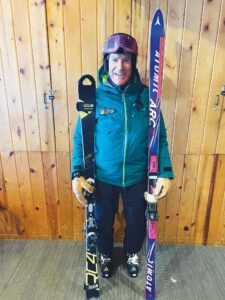By Dan Balkin

These things were big in the 1980s: MTV; the Swatch Watch; Atari; Rubik’s Cube; Wayne Gretsky; Meryl Streep; Raiders of the Lost Ark; Michael Jackson – and Straight Skis. A few of these persons or items slink along in the public mind in 2025, but not straight skis. Why? Because modern shaped skis are so much better.
A brief history of the evolution of modern skis: In 1882, the first mass-production ski factory opened in – where else? – Norway. Thirty years earlier, In the 1850s, the Norwegians had already invented the first “cambered” ski. A cambered ski means that when you place it flat on the ground, the center of the ski rises higher than the tip or tail. The purpose of this innovation, which is still widely used in ski design today, is that when one steps into bindings attached to the center of the ski, one’s weight is more evenly distributed over the entire length of the ski. In 1928, in one of the next giant leaps of ski-design innovation, Rudolph Lettner from Austria created the first skis with steel edges; in 1941, the first plastic base was put on a pair of Dynamic skis in France; in 1949, Howard Head – the man who Head skis are named after – manufactured the first metal ski; then innovations slowly progressed, but the actual “long and straight” design of skis remained unchanged for decades. Anyone who was lugging 190, 200, 207, or even 210 cm long straight skis to the mountain in the 1980s will remember the first time they saw a skilled snowboarder descend under the lift. They were “carving” exquisite arcs in the snow, while almost everyone else on straight skis were generally swiveling and sliding their ungodly long and cumbersome straight skis to make turns. Why? The snowboard was wider in the tip and tail, and narrower in the center. This innovative “shaped” design meant that when it was tipped on edge, it was capable of “carving” a round arc in the snow where the edge gripped instead of slid. It felt more secure and was a lot more fun! In the tradition-bound world of ski design, however, it took a while to learn from the design of the newfangled snowboard. There were some preliminary steps by other manufacturers, but in the early 1990s the Slovenian company Elan manufactured what became the first mass produced “parabolic” or “shaped” ski. It was known as the Elan SCX for “SideCut Extreme.” It was a sensation and kick-started the shaped ski revolution.
Steve Dunlap is an engineer, ski technique guru, and a race coach for our U16 and U18 (14–17-year-old) athletes at HoliMont. Steve is originally from Maine and raced in the Nor-Ams, which is only surpassed in ski racing by the World Cup. Very few competitors climb this high on ski racing’s pyramid of achievement. One day, during a race at Sugarloaf in Maine, a race coach pulled Steve aside and said, “Watch this next kid come down, he’ll either smoke the competition or crash spectacularly.” The kid won the race. The “kid” was a teenage Bode Miller. Bode, is not only a gifted athlete, but a deep thinker. He embraced shaped skis when other racers were clinging to traditional ski designs. In 1995, at the Junior National Championships at Sugarloaf, he threw tradition to the wind and decided to race on a ski called the K2 Four. It was not a race ski, but a high-end recreational ski and it had a new shaped design where the tip and tail were noticeably wider than underfoot. It “carved” better arcs in the snow and Bode won three out of four of the races; in the other race he placed second! News of this feat spread not only in North America but also in the traditional world of European ski racing. This proved to be one of the last nails sealing the coffin of straight skis. Shaped skis became accepted on the racecourse, which led to their increased popularization with recreational skiers. It was the shape of things to come…
